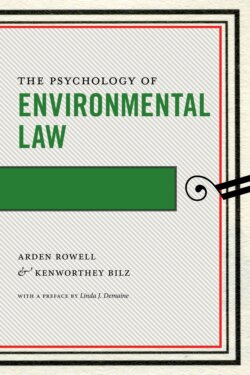Читать книгу The Psychology of Environmental Law - Arden Rowell - Страница 38
На сайте Литреса книга снята с продажи.
Key Aspects of the Psychology of Diffusion as Applied to Environmental Law
ОглавлениеEnvironmental injuries may be immediate and proximate, but more likely they will be spread across time or place relative to their source. When people engage in behaviors that benefit themselves but that consequently inflict harm on someone or something else, we say they create negative externalities.
Externalities may trigger moral disengagement, and where harms caused are diffuse, those externalities will be harder to see and easier to discount. Cognitive, emotional, and motivational phenomena that affect the psychology of diffusion include:
• Heuristics. Harms that are remote are less available to our conscious awareness, making them harder to count. Harms that are remote may be easier to ignore because of base rate neglect, which arises because of the representativeness heuristic. That is, harms that are in the background are easy to discount relative to immediate, present ones.
• Prospect theory/loss aversion. People devalue losses relative to equal magnitude gains, and they prefer to gamble to avoid losses but take certain gains. What counts as a loss or a gain tends to be evaluated from the current state of affairs because of the status quo bias. Thus, effects that happen in the future tend to be coded as a loss or a gain relative to the current state of affairs. Putting these things together, when faced with keeping a certain, immediate gain at the risk of causing an uncertain, future, or distant loss, people are likely to take the present benefit (gain) and gamble that the future harm (loss) won’t occur.
• Hedonic forecasting. People are not good at estimating how they will feel about either positive or negative events in the future. This causes them to overweight future events and fail to plan for them properly, meaning they may also inappropriately account for future environmental harms.
• Hyperbolic discounting and present bias. People experience temporal inconsistencies when thinking about future value. They overweight present value and overdiscount future value the further away it gets from them. This, again, can cause them to underappreciate the true future costs of environmental harms.
• Bargaining with the future. Because of the unidirectionality of time, it is not possible for stakeholders of the future to negotiate with those presently living to prevent future harms to themselves. This is another reason people undervalue future harms—there is literally no one at the table to make the case.
• In-group/out-group effects. To the extent environmental harms are spatially (and sometimes temporally) distant from those who cause them, it is easier for people to undercount them because they tend to undervalue the lives and needs of the “other.”
• Empathy and the identifiable victim effect. People are more likely to connect with and help/avoid harming individuals they can directly identify. When environmental harms are diffuse, they become more abstract and less individually identifiable, which interferes with people’s desire to help or avoid harming them.
